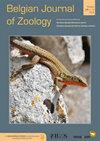Habitat preference by the Anatolian leopard (Panthera pardus tulliana Valenciennes, 1856) in North-eastern Anatolia, Turkey
IF 1.1
4区 生物学
Q2 ZOOLOGY
引用次数: 8
Abstract
This study aims to document the existence and habitat preferences of the Anatolian leopard ( Panthera pardus tulliana Valenciennes, 1856) in north-eastern Anatolia, Turkey. We sampled eleven study areas in 2013–2017, primarily based on our previous field experiences, reports from local people, and literature. Based on the findings from initial surveys, camera traps and leopard studies were mostly used in parts of the Giresun (Saricicek Mountain), Erzincan (Sansa Strait), and Bingol (Yedisu Valley) Provinces. We employed both direct observations and indirect observations. A total of 58 observations were recorded, ranging from 1176–3050 meters in altitude: six camera trap pictures, three thermal video camera images, three sightings by local people, 28 sets of tracks, 13 pieces of scat, two ground-scrapings, and three tree-scratches belonging to the Anatolian leopard. We defined eight habitat types and found that leopards preferred sparse forest areas, rocky habitats, and agriculture and pasture regions the most. Furthermore, 49 of 58 observations made in the sampling areas were detected in the southerly aspects of the study region. The Anatolian leopard habitat selection is mainly based on prey abundance, and we found that leopards prefer wild boar ( Sus scrofa ) the most, followed by wild goat ( Capra aegagrus ), chamois ( Rupicapra rupicapra ), and roe deer ( Capreolus capreolus ).土耳其安纳托利亚东北部安纳托利亚豹的栖息地偏好(Panthera pardus tulliana Valenciennes,1856)
本研究旨在记录安纳托利亚豹(Panthera pardus tulliana Valenciennes, 1856)在土耳其安纳托利亚东北部的存在及其栖息地偏好。我们在2013-2017年选取了11个研究区域,主要基于我们之前的实地经验、当地人的报告和文献。根据初步调查的结果,相机陷阱和豹子研究主要在Giresun (Saricicek山)、Erzincan (Sansa海峡)和Bingol (Yedisu山谷)省的部分地区使用。我们采用了直接观察和间接观察。在海拔1176-3050米的范围内,共记录了58个观测结果:6个相机陷阱图像,3个热摄像机图像,3个当地人目击,28组足迹,13块粪便,2个地面刮痕和3个属于安纳托利亚豹的树木刮痕。通过对8种栖息地类型的划分,发现豹子最喜欢疏林区、岩石栖息地和农牧区。此外,在采样区进行的58次观测中,有49次是在研究区域的南侧发现的。猎豹的栖息地选择主要基于猎物的丰度,猎豹最偏好野猪(Sus scrofa),其次是野山羊(Capra aegagrus)、岩羚羊(Rupicapra Rupicapra)和狍(Capreolus Capreolus Capreolus)。
本文章由计算机程序翻译,如有差异,请以英文原文为准。
求助全文
约1分钟内获得全文
求助全文
来源期刊

Belgian Journal of Zoology
生物-动物学
CiteScore
1.90
自引率
0.00%
发文量
10
审稿时长
>12 weeks
期刊介绍:
The Belgian Journal of Zoology is an open access journal publishing high-quality research papers in English that are original, of broad interest and hypothesis-driven. Manuscripts on all aspects of zoology are considered, including anatomy, behaviour, developmental biology, ecology, evolution, genetics, genomics and physiology. Manuscripts on veterinary topics are outside of the journal’s scope. The Belgian Journal of Zoology also welcomes reviews, especially from complex or poorly understood research fields in zoology. The Belgian Journal of Zoology does no longer publish purely taxonomic papers. Surveys and reports on novel or invasive animal species for Belgium are considered only if sufficient new biological or biogeographic information is included.
 求助内容:
求助内容: 应助结果提醒方式:
应助结果提醒方式:


